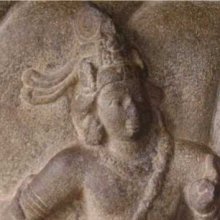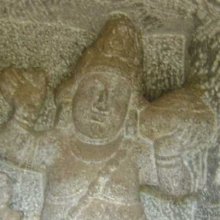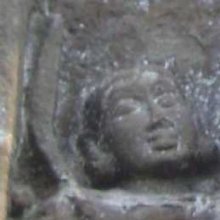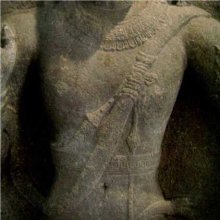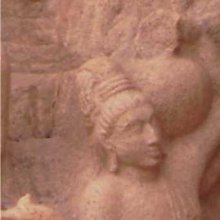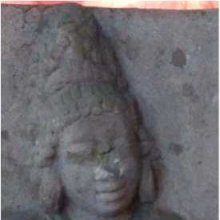Vastra, Vāstra: 30 definitions
Introduction:
Vastra means something in Buddhism, Pali, Hinduism, Sanskrit, Marathi, Hindi, biology. If you want to know the exact meaning, history, etymology or English translation of this term then check out the descriptions on this page. Add your comment or reference to a book if you want to contribute to this summary article.
Images (photo gallery)
(+3 more images available)
In Hinduism
Purana and Itihasa (epic history)
Source: archive.org: Nilamata Purana: a cultural and literary studyVastra (वस्त्र) is a general name for “clothing” once commonly made by craftsmen in ancient Kashmir (Kaśmīra) as mentioned in the Nīlamatapurāṇa.—Craftsmen and their tools are referred to in the Nīlamata which enjoins upon the inhabitants of Kaśmīra the worship of Viśvakarmā—the originator of all crafts.
Source: archive.org: Shiva Purana - English Translation1) Vastra (वस्त्र, “cloth”) refers to “offering of cloth” and represents one of the sixteen upacāra, or “sixteen types of homage and services”, as described while explaining the mode of worshipping the phallic form (liṅga) of Śiva in the Śivapurāṇa 1.11. Accordingly, “[...] the devotee shall worship the mobile emblem with the sixteen types of homage and services (upacāra) as prescribed. It accords the region of Śiva gradually. The sixteen types of service are [for example, offering of cloth (vastra)] [...] Or he shall perform all the sixteen rites in the phallic emblem of human, saintly or godly origin, or in one naturally risen up (svayambhū) or in one of very extraordinary nature installed duly”.
Vastra or Vastrasamarpaṇa (offering of cloth) is also mentioned in the Śivapurāṇa 1.20, while explaining the mode of worshipping an earthen phallic image (pārthiva-liṅga) according to the Vedic rites:—“[...] the pious follower of Vedic rites shall make an offering of cloth (vastra-samarpaṇa) duly to Śiva with the four hymns beginning with ‘‘Yā te heti’ etc.”.
2) Vastra (वस्त्र, “cloth”) refers to “silken clothes” which forms part of the royal paraphernalia (mahārājopacāra), according to the Śivapurāṇa 2.2.28. Accordingly as Brahmā narrated to Nārada:—“[...] Lord Śiva, possessed of the perfect vision, realising everything and seeing all, and the cause of protection, being requested by the Goddess, spoke to her:—‘[...] You can go in royal splendour mounting this bull richly caparisoned’. Satī thus commanded to mount the decorated bull, bedecked herself and started for her father’s abode. The royal paraphernalia (mahārājopacāra) like the umbrella, chowries, silken clothes (vastra) and ornaments were given to her by (Śiva) the great lord”.

The Purana (पुराण, purāṇas) refers to Sanskrit literature preserving ancient India’s vast cultural history, including historical legends, religious ceremonies, various arts and sciences. The eighteen mahapuranas total over 400,000 shlokas (metrical couplets) and date to at least several centuries BCE.
Shaivism (Shaiva philosophy)
Source: Shodhganga: Temple management in the ĀgamasVastra (वस्त्र) refers to “new/ washed clothes” and represents one of the various upacāras (offerings), in pūjā (ritual worship), as defined in the Śaivāgamas.—Pūjā consists of offering hospitality, in the form of water to wash the feet, to drink, water for ablutions, offering a bath, new clothes, fragrant unguents, fragrant flowers and ornaments, food and so on. Each step in the pūjā process is called “saṃskāra” and each offering is called “upacāra” [viz., Vastra].
Source: Brill: Śaivism and the Tantric Traditions1) Vastra (वस्त्र) refers to a “garment”, according to the Guhyasūtra chapter 9.—Accordingly, “[...] [The Lord spoke]:—[...] On one half, there should be a forehead mark; on one half a [forehead] eye. A ring [should be] in one ear; a [pendant] ear-ornament in one ear. He should put a trident in his right hand and a breast on his left side, a girdle on the left half, a bangle on the left arm, a woman’s anklet on the left leg, a man’s anklet on the right leg and a muñja-grass belt. At the hips, he should put a loin-cloth on the right and wear a woman’s garment (strī-vastra-dhārin) on the left. [...]”.
2) Vastra (वस्त्र) refers to “clothes” (of one’s Guru), according to the 13th-century Matsyendrasaṃhitā: a Kubjikā-Tripurā oriented Tantric Yoga text of the Ṣaḍanvayaśāmbhava tradition from South India.—Accordingly, “After this, O Śivā, hear the exposition of the Kula Conduct. After he has joined the tradition of the Siddhas, he should worship his guru as divine. The Yogin who is engaged in the worship of his guru can obtain the highest Power. The guru’s bedstead, his bedding, clothes (vastra), ornaments, sandals, parasol, antilope-skin, bowl or anything else: if he touches any of these with his feet, he should place them on his head and recite [mantras] eight times. [...]”.
Source: SOAS University of London: Protective Rites in the Netra TantraVastra (वस्त्र) refers to “clothes” (in dreams), according to the Svacchanda-tantra.—Accordingly, [verse 4.21-27, while describing inauspicious dreams]—“[...] [He dreams of] the destruction of houses, palaces, beds, clothes (vastra), and seats (śayyāvastrāsaneṣu); defeat of oneself in battle and theft of ones things. [He] ascends or is amongst donkeys, camels, dogs, jackals, and herons, vultures, and cranes. [He rides on] buffalos, owls, and crows, eats cooked meat, [wears a] red garland, and ointment for the body. [...]”

Shaiva (शैव, śaiva) or Shaivism (śaivism) represents a tradition of Hinduism worshiping Shiva as the supreme being. Closely related to Shaktism, Shaiva literature includes a range of scriptures, including Tantras, while the root of this tradition may be traced back to the ancient Vedas.
Vaishnavism (Vaishava dharma)
Source: Pure Bhakti: Arcana-dipika - 3rd EditionVastra (वस्त्र) refers to “cloth” and represents one of the articles offered during Maṅgalārati, according to the Arcana-dīpikā (manual on deity worship).—Before each article is offered, purify the right hand [with a drop of water from the pañca-pātra], and then purify the article [viz., vastra]. Chant the mūla-mantra for the deity and then offer the article.

Vaishnava (वैष्णव, vaiṣṇava) or vaishnavism (vaiṣṇavism) represents a tradition of Hinduism worshipping Vishnu as the supreme Lord. Similar to the Shaktism and Shaivism traditions, Vaishnavism also developed as an individual movement, famous for its exposition of the dashavatara (‘ten avatars of Vishnu’).
Shilpashastra (iconography)
Source: Shodhganga: Vaisnava Agamas And Visnu ImagesVastra (वस्त्र) refers to “garments” (i.e., ornamental), as defined in treatises such as the Pāñcarātra, Pādmasaṃhitā and Vaikhānasa-āgamas, extensively dealing with the technical features of temple art, iconography and architecture in Vaishnavism.—According to the texts there are two type of clothing or robes, namely the bandhas and the vastras. [...] Vastra, also called Ambara, is the typical robe which drapes the lower part of the body, of both female and male icons. This is wrapped around the waist girdles, and consist either in a long garment, reaching just above the ankles or in a shorter one having a broad and well-defined border (ambarānta), seen just above the knees.

Shilpashastra (शिल्पशास्त्र, śilpaśāstra) represents the ancient Indian science (shastra) of creative arts (shilpa) such as sculpture, iconography and painting. Closely related to Vastushastra (architecture), they often share the same literature.
Ayurveda (science of life)
Source: gurumukhi.ru: Ayurveda glossary of termsVastra (वस्त्र):—Clothes.

Āyurveda (आयुर्वेद, ayurveda) is a branch of Indian science dealing with medicine, herbalism, taxology, anatomy, surgery, alchemy and related topics. Traditional practice of Āyurveda in ancient India dates back to at least the first millenium BC. Literature is commonly written in Sanskrit using various poetic metres.
Jyotisha (astronomy and astrology)
Source: Wisdom Library: Brihat Samhita by VarahamihiraVastra (वस्त्र) refers to “clothes”, according to the Bṛhatsaṃhitā (chapter 2), an encyclopedic Sanskrit work written by Varāhamihira mainly focusing on the science of ancient Indian astronomy astronomy (Jyotiṣa).—Accordingly, “A true Astrologer is also one who has thoroughly mastered the Science of Saṃhitā. [...] It also treats of the prediction of events from the flight of the kañjana and from the appearance of various abnormal phenomena, of expiatory ceremonies; of miscellaneous planetary phenomena; of ghṛta-kambala; of the royal sword; of paṭa; of the features of a house cock, a cow, a sheep, a horse, an elephant, a man and a woman. It also treats of the treatment of women; of moles in the body; of injuries to shoes and clothes [i.e., vastra-cheda]; of hairy fans; of walking sticks: of beds and seats; of lamplight; of tooth brush and the like”.
Source: Google Books: Studies in the History of the Exact Sciences (Astronomy)Vastra (वस्त्र) refers to “clothes”, according to the Nāradasaṃhitā verse 29.86-95 (pp. 181-184), a Sanskrit work on astrology having the Saralā commentary by Vasatirāma Śarmā.—Accordingly, “[...] In an auspicious copper basin, or in a clay basin that has been filled with water, having decorated it with effort by means of sandal paste, flowers and coloured rice, the basin which is placed upon grains of rice, to which a gold piece is added and which is covered by a pair of clothes [i.e., vastra-yugma], one should place the bowl after having seen the rise of half of the Sun’s orb. [...]”.

Jyotisha (ज्योतिष, jyotiṣa or jyotish) refers to ‘astronomy’ or “Vedic astrology” and represents the fifth of the six Vedangas (additional sciences to be studied along with the Vedas). Jyotisha concerns itself with the study and prediction of the movements of celestial bodies, in order to calculate the auspicious time for rituals and ceremonies.
Vastushastra (architecture)
Source: Brill: Śaivism and the Tantric Traditions (architecture)Vastra (वस्त्र) refers to “cloths ”, according to the Devyāmata (chapter 105).—Accordingly, [while describing the layout of the residence (gṛha) for the prāsādāśramin]—“[...] Storage for gems, gold and cloths (vastra) is recommended in the east, and for water in the south and centre. Grain storage is recommended in the west. In the northwest is storage for the mortar. [...]”.

Vastushastra (वास्तुशास्त्र, vāstuśāstra) refers to the ancient Indian science (shastra) of architecture (vastu), dealing with topics such architecture, sculpture, town-building, fort building and various other constructions. Vastu also deals with the philosophy of the architectural relation with the cosmic universe.
Dharmashastra (religious law)
Source: HAL: The function of the Vṛṣasārasaṃgraha in the Śivadharma corpus (ds)Vastra (वस्त्र) refers to “clothes”, attachment to which should be avoided by Saṃnyāsas (renouncers), according to the Vṛṣasārasaṃgraha: A Sanskrit text of twenty-four chapters contained in the Śivadharma corpus dealing with Dharma (religious duties).—Accordingly, [verse 11.52-53]: “He should go on his alms round visiting seven houses at the eighth part of the day. He should not sit down, he should not stay, and he should not say ‘Give me!’ He should live on what is available, on eight bites a day. He should not stick to items of clothes (vastra), food or a bed for long”.

Dharmashastra (धर्मशास्त्र, dharmaśāstra) contains the instructions (shastra) regarding religious conduct of livelihood (dharma), ceremonies, jurisprudence (study of law) and more. It is categorized as smriti, an important and authoritative selection of books dealing with the Hindu lifestyle.
Sports, Arts and Entertainment (wordly enjoyments)
Source: archive.org: Syainika Sastra of Rudradeva with English Translation (art)Vastra (वस्त्र) refers to a “piece of cloth” (used in Hawking), according to the Śyainika-śāstra: a Sanskrit treatise dealing with the divisions and benefits of Hunting and Hawking, written by Rājā Rudradeva (or Candradeva) in possibly the 13th century.—Accordingly, “The casting [of hawks] is of two kinds—Hastamoka and Muṣṭimoka. [...] In Muṣṭimoka a hawk is thrown by grasping it in the palm of the hand, the hawk’s feathers being protected by a piece of cloth (vastra-antarita) [vastrāntaritamāveśya], taking care that the hawk’s flight is not impeded by the cloth”.

This section covers the skills and profiencies of the Kalas (“performing arts”) and Shastras (“sciences”) involving ancient Indian traditions of sports, games, arts, entertainment, love-making and other means of wordly enjoyments. Traditionally these topics were dealt with in Sanskrit treatises explaing the philosophy and the justification of enjoying the pleasures of the senses.
General definition (in Hinduism)
Source: ACHC: Smarta PujaVastra (वस्त्र) refers to the “offering of garments”, representing one of the various services (upacāra) of a pūjā (ritualistic worship of a deity) which aim at the purification of the devotee.—Next [after abhiṣeka] a lower garment together with an upper garment is offered. These garments (vastra) are, according to the old Indian style of clothing two untailored pieces of cloth. In the daily worship, especially in case of small icons, often pieces of cotton wool arranged in form of a garland, silken pieces of cloth or an offering of unbroken rice (akṣata) serve as a substitute. Some texts specify the color of the garments that should be offered: A yellow garment to Viṣṇu, a white one to Śiva, a red one to Ganapati, Devī and Surya. Garments colored blue with indigo (unless they are made of silk or wool should not be offered. After the offering of garments water for sipping is given.
In Buddhism
Mahayana (major branch of Buddhism)
Source: Wisdom Library: Maha Prajnaparamita SastraVastra (वस्त्र) refers to “garments” and is mentioned among the “material benefits” granted by the Bodhisattva, according to the Mahāprajñāpāramitāśāstra chapter XLVI.—Garments (vastra) are of two kinds:
- some come from living beings such as silks (paṭṭaka), furs (roman), tanned leathers (carman), etc.;
- others come from plants such as cottons (kārpāsa), tree bark (valkala), etc.
There are also the garments of the gods: they have no fabric and arise spontaneously (svarasena) on trees: they are brilliant in color, light and soft.
Source: De Gruyter: A Buddhist Ritual Manual on AgricultureVastra (वस्त्र) refers to “cloths” (suitable for worship), according to the Vajratuṇḍasamayakalparāja, an ancient Buddhist ritual manual on agriculture from the 5th-century (or earlier), containing various instructions for the Sangha to provide agriculture-related services to laypeople including rain-making, weather control and crop protection.—Accordingly, [after the Bhagavān entered the assembly of Nāgas], “Then the great Nāga king Samantākāracchatrākaraparikara arose from his seat, arranged his outer robe on one shoulder, placed his right knee on the ground, approached the Bhagavān and, having bowed down at his feet, circumambulated him three times, and worshipped the Bhagavān with different flowers, fragrances, garlands, ointments, ornaments and cloths [e.g., nānāṛvastra]. Having worshipped him, he sat down in front of him”.

Mahayana (महायान, mahāyāna) is a major branch of Buddhism focusing on the path of a Bodhisattva (spiritual aspirants/ enlightened beings). Extant literature is vast and primarely composed in the Sanskrit language. There are many sūtras of which some of the earliest are the various Prajñāpāramitā sūtras.
Tibetan Buddhism (Vajrayana or tantric Buddhism)
Source: Brill: Śaivism and the Tantric Traditions (tantric Buddhism)Vastra (वस्त्र) refers to a “garment”, according to Kuladatta’s Kriyāsaṃgrahapañjikā, a text within Tantric Buddhism representing a construction manual for monasteries.—Accordingly, [while describing pratiṣṭhā in chapter 4]—“Then the king should satisfy the architects, the assistants, and the spectators with a bracelet, a finger-ring, a garment (vastra), gold, heap of chaplet, tāmbūla, or other [articles] according to [the donor’s] wealth”.

Tibetan Buddhism includes schools such as Nyingma, Kadampa, Kagyu and Gelug. Their primary canon of literature is divided in two broad categories: The Kangyur, which consists of Buddha’s words, and the Tengyur, which includes commentaries from various sources. Esotericism and tantra techniques (vajrayāna) are collected indepently.
Biology (plants and animals)
Source: Google Books: CRC World Dictionary (Regional names)Vastra in India is the name of a plant defined with Cinnamomum tamala in various botanical sources. This page contains potential references in Ayurveda, modern medicine, and other folk traditions or local practices It has the synonym Laurus tamala Buch.-Ham. (among others).
Example references for further research on medicinal uses or toxicity (see latin names for full list):
· FBI (1886)
· Botanica expeditior (1760)
· Transactions of the Linnean Society of London (1822)
· Handbuch der medicinisch-pharmaceutischen Botanik (1831)
· Species Plantarum (1753)
If you are looking for specific details regarding Vastra, for example pregnancy safety, diet and recipes, extract dosage, chemical composition, health benefits, side effects, have a look at these references.

This sections includes definitions from the five kingdoms of living things: Animals, Plants, Fungi, Protists and Monera. It will include both the official binomial nomenclature (scientific names usually in Latin) as well as regional spellings and variants.
Languages of India and abroad
Marathi-English dictionary
Source: DDSA: The Molesworth Marathi and English Dictionaryvastra (वस्त्र).—n (S) Cloth: also a cloth. 2 An article of apparel or raiment: also apparel, dress, clothes. Pr.lābha pāñcāñcā āṇi vastra dāhācēṃ Descriptive of a fop,--one who, earning five rupees, spends ten upon his attire. ēkā vastrānēṃ nighaṇēṃ See the phrase ēkā aṅgavastrānēṃ nighaṇēṃ. kāḷīṃ vastrēṃ dēṇēṃ To give black articles of apparel (śēlā, pāgōṭēṃ &c.) in intimation of dismissal (as by a king to a minister &c.) Hence To dismiss or discharge generally. vastra hōṇēṃ in. con. To get a good appointment or place: also, ironically, to be dismissed from a good place. vastrāntara hōṇēṃ g.of s. To shift or change one's dress.
--- OR ---
vastrā (वस्त्रा).—m ( P) A razor. 2 Applied figuratively to a sharp, prompt, or acute speaker; to keen, cutting speech &c.
Source: DDSA: The Aryabhusan school dictionary, Marathi-Englishvastra (वस्त्र).—n Cloth; an article of apparel; dress.
--- OR ---
vastrā (वस्त्रा).—m A razor.
Marathi is an Indo-European language having over 70 million native speakers people in (predominantly) Maharashtra India. Marathi, like many other Indo-Aryan languages, evolved from early forms of Prakrit, which itself is a subset of Sanskrit, one of the most ancient languages of the world.
Sanskrit dictionary
Source: DDSA: The practical Sanskrit-English dictionaryVastra (वस्त्र).—[vas-ṣṭran Uṇādi-sūtra 4.172]
1) A garment, cloth, clothes, raiment; स्नातस्यानन्तरं सम्यग् वस्त्रेण तनुमार्जनम् । कान्ति- प्रदं शरीरस्य कण्डूयादोषनाशनम् ॥ कौषेयं चित्रवस्त्रं च रक्तवस्त्रं तथैव च । वातश्लेष्महरं तत्तु शीतकाले विधारयेत् ॥ मेध्यं सुशीतं पित्तघ्नं काषायं वस्त्रमुच्यते । तद्धारयेदुष्णकाले तच्चापि लघु शस्यते ॥ शुक्लं तु शुभदं वस्त्रं शीतातपनिवारणम् । न चोष्णं न च वा शीतं तत्तु वर्षासु धारयेत् (snātasyānantaraṃ samyag vastreṇa tanumārjanam | kānti- pradaṃ śarīrasya kaṇḍūyādoṣanāśanam || kauṣeyaṃ citravastraṃ ca raktavastraṃ tathaiva ca | vātaśleṣmaharaṃ tattu śītakāle vidhārayet || medhyaṃ suśītaṃ pittaghnaṃ kāṣāyaṃ vastramucyate | taddhārayeduṣṇakāle taccāpi laghu śasyate || śuklaṃ tu śubhadaṃ vastraṃ śītātapanivāraṇam | na coṣṇaṃ na ca vā śītaṃ tattu varṣāsu dhārayet) || Bhāva., P.
2) Dress, apparel.
3) A leaf of the cinnamon tree.
Derivable forms: vastram (वस्त्रम्).
--- OR ---
Vāstra (वास्त्र).—a. [vastra-aṇ] Made of cloth.
-straḥ A carriage covered with cloth.
Source: Cologne Digital Sanskrit Dictionaries: Shabda-Sagara Sanskrit-English DictionaryVastra (वस्त्र).—n.
(-straṃ) 1. Cloth, clothes, raiment. 2. Covering, a cover. E. vas to wear, (as clothes,) ṣṭran Unadi aff.
--- OR ---
Vāstra (वास्त्र).—mfn.
(-straḥ-strā-straṃ) Cloth, made of or covered with cloth, &c. E. vastra cloth, aṇ aff.
Source: Cologne Digital Sanskrit Dictionaries: Benfey Sanskrit-English DictionaryVastra (वस्त्र).—[vas + tra] 3., n. m. Cloth, garment, [Pañcatantra] 29, 10; bed-linen, 62, 13.
--- OR ---
Vāstra (वास्त्र).—i. e. vastra + a, adj. Covered with cloth.
Source: Cologne Digital Sanskrit Dictionaries: Cappeller Sanskrit-English DictionaryVastra (वस्त्र).—[neuter] cloth, garment; clothes, dress.
Source: Cologne Digital Sanskrit Dictionaries: Monier-Williams Sanskrit-English Dictionary1) Vastra (वस्त्र):—[from vas] n. (or m. [gana] ardharcādi; ifc. f(ā). ) cloth, clothes, garment, raiment, dress, cover, [Ṛg-veda] etc. etc.
2) Vastrā (वस्त्रा):—[from vastra > vas] f. Name of a river, [Viṣṇu-purāṇa]
3) Vastra (वस्त्र):—[from vas] n. a leaf of the cinnamon tree, [cf. Lexicographers, esp. such as amarasiṃha, halāyudha, hemacandra, etc.]
4) Vāstra (वास्त्र):—mfn. ([from] vastra) covered with cloth, [Pāṇini 4-2, 10 [Scholiast or Commentator]]
Source: Cologne Digital Sanskrit Dictionaries: Yates Sanskrit-English Dictionary1) Vastra (वस्त्र):—(straṃ) 1. n. Cloth, clothes, covering.
2) Vāstra (वास्त्र):—[(straḥ-strā-straṃ) a.] Made of or covered with cloth. m. Cloth.
Source: DDSA: Paia-sadda-mahannavo; a comprehensive Prakrit Hindi dictionary (S)Vastra (वस्त्र) in the Sanskrit language is related to the Prakrit word: Vattha.
[Sanskrit to German]
Sanskrit, also spelled संस्कृतम् (saṃskṛtam), is an ancient language of India commonly seen as the grandmother of the Indo-European language family (even English!). Closely allied with Prakrit and Pali, Sanskrit is more exhaustive in both grammar and terms and has the most extensive collection of literature in the world, greatly surpassing its sister-languages Greek and Latin.
Hindi dictionary
Source: DDSA: A practical Hindi-English dictionaryVastra (वस्त्र):—(nm) cloth(es), textile, fibre, raiment; —[vinyāsa] drapery.
...
Kannada-English dictionary
Source: Alar: Kannada-English corpusVastra (ವಸ್ತ್ರ):—
1) [noun] a woven fabric; cloth.
2) [noun] any article of clothing; a garment; clothe; a costume.
Kannada is a Dravidian language (as opposed to the Indo-European language family) mainly spoken in the southwestern region of India.
See also (Relevant definitions)
Starts with (+90): Vastrabaddha, Vastrabandha, Vastrabharana, Vastrabhedaka, Vastrabhedin, Vastrabhinnaka, Vastrabhushan, Vastrabhushana, Vastraca Tana, Vastracchanna, Vastracheda, Vastrachheda, Vastrada, Vastradana, Vastradanakatha, Vastradasha, Vastradhara, Vastradharaka, Vastradharani, Vastradharin.
Ends with (+107): Abdhivastra, Acchadanavastra, Achchhadanavastra, Adhivastra, Agnishaucavastra, Amtarvastra, Amulyavastra, Anamdavastra, Angavastra, Annavastra, Antarvastra, Ardravastra, Arunavastra, Astaraniyavastra, Aupavastra, Avastra, Batuvastra, Citravastra, Dantavastra, Devamgavastra.
Full-text (+283): Snanavastra, Vastranirnejaka, Netravastra, Vastrayoni, Dantavastra, Antarvastra, Nilavastra, Vastragranthi, Divyavastra, Vastrapaharaka, Adhivastra, Vastragriha, Vivastra, Jirnavastra, Vastrabhedin, Avastrata, Vastrayugma, Vastrayugala, Knopam, Vastrapeshi.
Relevant text
Search found 51 books and stories containing Vastra, Vastrā, Vāstra; (plurals include: Vastras, Vastrās, Vāstras). You can also click to the full overview containing English textual excerpts. Below are direct links for the most relevant articles:
Garga Samhita (English) (by Danavir Goswami)
Verse 6.19.38 < [Chapter 19 - In the First Fortress of Dvārakā, the Glories of Līlā-sarovara, etc.]
Verse 1.17.33 < [Chapter 17 - Description of the Yogurt Theft]
Verse 3.1.18 < [Chapter 1 - The Worship of Śrī Girirāja]
Rig Veda (translation and commentary) (by H. H. Wilson)
The Markandeya Purana (Study) (by Chandamita Bhattacharya)
Dress and Clothing < [Chapter 2]
Vivekachudamani (by Shankara)
Bhakti-rasamrta-sindhu (by Śrīla Rūpa Gosvāmī)
Verse 2.1.349 < [Part 1 - Ecstatic Excitants (vibhāva)]
Verse 2.1.315 < [Part 1 - Ecstatic Excitants (vibhāva)]
Verse 2.5.69 < [Part 5 - Permanent Ecstatic Mood (sthāyī-bhāva)]
